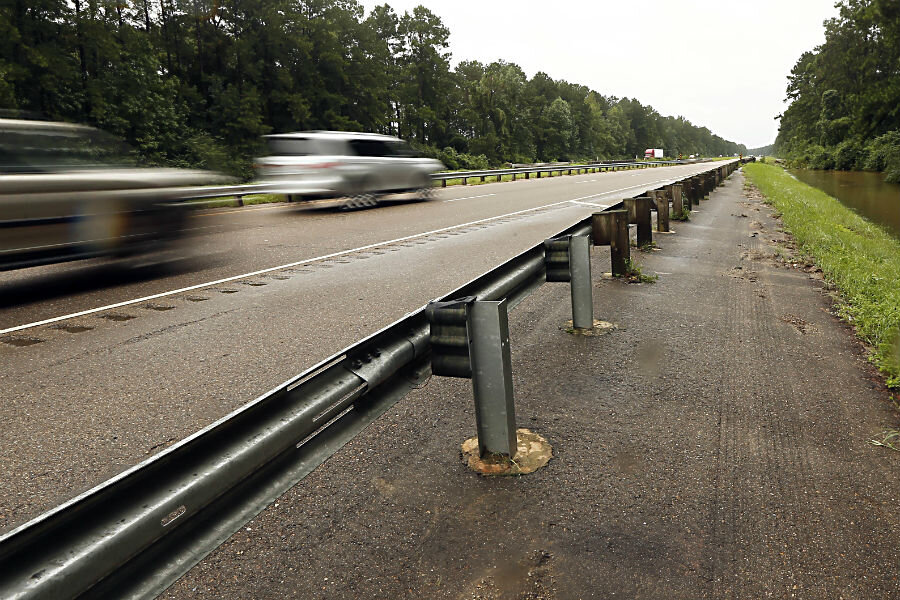Why motor vehicle traffic deaths are rising again this year
| Washington
Traffic fatalities were up 9 percent in the first six months of this year compared to the same period last year, continuing a surge in deaths that began two years ago as the economy improved, gasoline prices went down, and highway travel picked up, according to preliminary estimates released Tuesday by the National Safety Council.
An estimated 19,100 people were killed on U.S. roads from January through June, said the council, a congressionally chartered nonprofit that gets its data from state authorities. That's 18 percent more than two years ago at the six-month mark. About 2.2 million people also were seriously injured in the first half of this year.
The council estimates the cost of these deaths and injuries at about $205 billion.
At that rate, annual deaths could exceed 40,000 fatalities this year for the first time in nine years, the council said. More than 35,000 people were killed on U.S. roads last year, making it the deadliest driving year since 2008, when more than 37,000 were killed.
"Our complacency is killing us," said Deborah A.P. Hersman, the safety council's president and CEO. "Americans should demand change to prioritize safety actions and protect ourselves from one of the leading causes of preventable death."
U.S. drivers have also put in a record 1.58 trillion miles on the road in the first half of this year, a 3.3 percent increase over the same period in 2015, the Federal Highway Administration said this week.
States with the biggest increases since the upward traffic fatality trend began in late 2014 include Vermont, up 82 percent; Oregon, 70 percent; New Hampshire, 61 percent; Idaho, 46 percent; Florida, 43 percent; Iowa, 37 percent; Georgia, 34 percent; Indiana, 33 percent; California, 31 percent and Wisconsin, 29 percent.
"While many factors likely contributed to the fatality increase, a stronger economy and lower unemployment rates are at the core of the trend," the council said in a statement. Another likely factor: Average gas prices for the first six months of this year were 16 percent lower than in 2015.
The council also predicts that 438 people will be killed on the nation's roads over the three-day Labor Day weekend that begins Sept. 2, which would make it the deadliest Labor Day weekend since 2008.
Historical data show that after peaking in the 1970s, traffic deaths have generally trended downward, according to the Insurance Institute for Highway Safety. Large dips in deaths have corresponded to shocks to the economy — the oil embargo of the mid-1970s, the recessions of the early 1980s and early 1990s and the more recent downturn that began in late 2007 with the subprime mortgage crisis.
During the Great Recession triggered by the housing crisis, the number of miles Americans put on the road each year plunged and fatalities dropped to levels not seen since Harry Truman was president.
The council's tallies of traffic fatalities differ slightly from those of the National Highway Traffic Safety Administration because the council includes motor vehicle deaths that take place in parking lots, driveways and other nonpublic roadways.
A year ago, after a similar year-over-year rise in traffic deaths, the Associated Press reported that in recent decades, deaths due to crashes involving drunken driving have dropped from about 50 percent of fatalities to about 30 percent, she said. Teen driving deaths are also down, and seatbelt use is up. And cars have more safety technology than ever, although drivers sometimes don't use it or don't know how to use it, Ms. Hersman said.
On the other hand, a growing number of states are raising speed limits, and everywhere drivers are distracted by cellphone calls and text messages. The council estimated in a report this spring that a quarter of all crashes involve cellphone use. Besides fatal crashes, that includes injury-only and property damage-only crashes.
"For many years people have said, 'If distraction is such a big issue, why don't we see an increase in fatal crash numbers?' Well, we're seeing increasing fatal crashes numbers, but I think it's complicated to tease out what that is due to," Hersman said.
___






